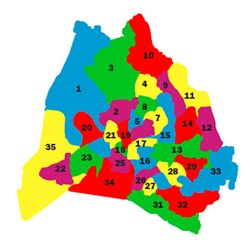VOL. 35 | NO. 11 | Friday, March 18, 2011
Metro eyes Council redistricting; population shifts south
By Judy Sarles

Existing Metro Council districts
Davidson County’s continuing population shift might soon result in more and smaller Metro Council districts in the southern portions of the county.
Once it receives 2010 Census data, Metro Planning Department expects to have a redistricting plan ready within a week, allowing time for the Planning Commission and Metro Council to approve the plan for redrawing district boundaries prior to the May 19 filing deadline for Aug. 4 Council elections.
However, if Metro Council rejects the redistricting plan and decides to come up with its own plan, it is unlikely a redistricting plan will be in place by May 19 or even by the Aug. 4 election.
“By charter, (Council) can reject it and propose their own plan,” says Jon Cooper, Metro Council attorney. “In which case, both plans would go to the voters to decide.”
If there is no redistricting plan prior to the Aug. 4 election, Metro Council candidates could be elected in districts that will change once a redistricting plan is in place.
“Assuming the Planning Commission approves the plan at the end of March that they’ve outlined,” Cooper says, “if the redistricting was going to take place before the August election, the Council would basically have to acquiesce to whatever the Planning Commission approves.”
An alternative would be for the Tennessee coordinator of elections to alter the timeframe from qualifying date to the election.
“It is highly unusual for it to move, but it is technically possible,” says Albert V. Tieche, administrator of elections for the Davidson County election Commission.
In 1971, Census data was received Feb. 16 but not approved by Council until May 4.
In 1991, Metro Council refused to sign off on the Planning Commission’s redistricting plan. That year, Census data was received March 19, the plan was approved by the Planning Commission April 25 and filed April 30. Council rejected the plan June 3 on second reading and approved an alternative plan July 19. A referendum was held Sept. 5.
Metro Charter stipulates the Planning Commission has six months following the receipt of Census numbers to approve a redistricting plan. This year’s deadline is Oct. 1. Metro Planning was told on March 10 to expect the Census data sometime during the week of March 14. Metro Planning Commission expects to hold a special meeting April 7 to consider the plan for approval.
Under threat of a lawsuit by attorney George Barrett, the Planning Department has already been working on a plan based on 2005-2009 population estimates provided by the federal government’s “American Community Survey.” The preliminary plan is expected to provide a general idea of what lines might be redrawn.
Speculation is that the districts in Southeast and Southwest Davidson County will get smaller and the districts in the central and rural northern part of the county will get bigger. The redistricting plan will also determine Metro Nashville School Board districts. Five current school board members have terms that expire in 2012.
“The goal here is to try to make the population in each Council District as close to the same as possible, give or take 5 percent,” says Craig Owensby, spokesman for the Planning Department.
There are eight basic guidelines the Planning Department will incorporate in redrawing the Council districts:
• Equal Population Requirement.
• Compliance with the Voting Rights Act.
• Compact with contiguous territory.
• Minimize deviation from existing districts.
• Satellite cities not split by Council districts.
• Maintain neighborhood boundaries.
• Utilize natural boundaries as practical.
• Public comments.
According to Rick Bernhardt, Metro Planning Department executive director, the county’s overall population has increased by more than 10 percent, from 569,891 in 2000 to 635,710 in 2009. The ideal is for each of Metro’s 35 districts to have an increase in population of about 1,880 people, from the 16,283 population figure in 2000.
Besides exact population growth in each district, Census data will also provide a picture of where Metro’s ethnic population is growing and which neighborhoods are experiencing shrinking or expanding populations.
Through a website the Planning Department is implementing, Metro residents will be able to track the department’s daily progress on formulating a redistricting plan. There will be a place on the site for public comment, and comments will be read and included in the process each day.
On the site will be side-by-side maps of current and proposed districts, as well as a link for e-mailed comments. Planners will receive the comments, which will be available on the site for public review. A public presentation for Council members and one for a general audience will be scheduled as part of the process to develop a redistricting plan.
Owensby says he doesn’t have a specific figure on the cost to his department to design a redistricting plan, but the cost has been minimal. The department bought some software that interfaces with its existing software. One staff member is working on the plan full time and several other staff members are spending some of their time on it.